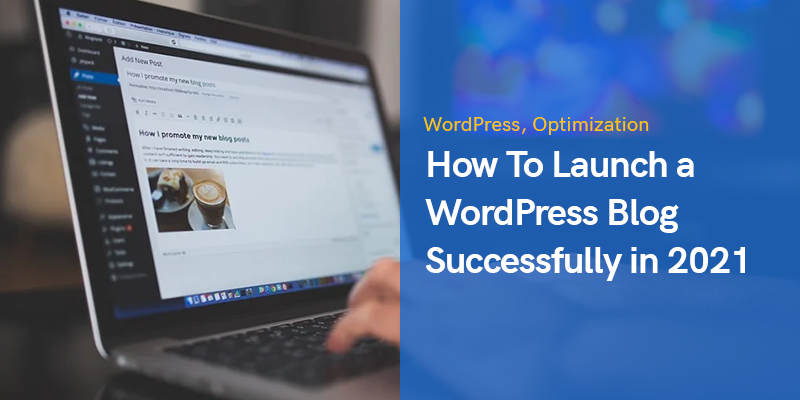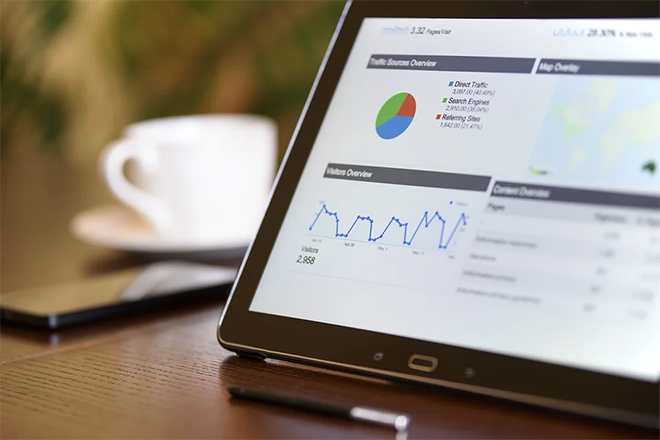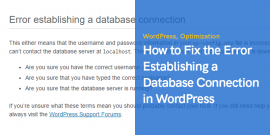
How To Launch a WordPress Blog Successfully in 2023
Starting a blog is thrilling, and WordPress gives wannabe bloggers optimism. This platform, known for its simplicity and flexibility, has changed website building and maintenance.
This post will guide you through WordPress blogging's complex world, whether you're a beginner or an experienced webmaster wishing to improve.
WordPress is an excellent platform with lots of amazing page builders that makes it easier than ever for people to create their own sites.
That’s great, but it does mean that thousands of new WordPress blogs are launched every single day.
If you want people to read yours, you need to take steps to make sure that everything is perfect and your site stands out from the crowd before you launch it.
Why Choose WordPress?
WordPress is perfect for novices due to its user-friendly interface. Despite its simplicity, it can handle even the most demanding web admins.
You can customize it like no other with thousands of themes and plugins. SEO-conscious people will love WordPress. Its SEO-friendly configuration boosts blog exposure and audience reach on search engine results.
The world's most popular CMS's ample community support is crucial, especially when starting.
Step 1: Choosing a Domain Name and Hosting Provider
Choose a domain name and a hosting provider to start your WordPress blog. Domain names are unique addresses that represent your blog online. A memorable and relevant domain name is crucial for sharing material.
Selecting a Domain Name
Domain name relevancy matters. Potential readers should immediately understand your blog's topic from its name. It should also be easy to remember and pronounce to encourage word-of-mouth and return visits. Keywords related to your blog's niche can boost SEO.
Finding the Right Hosting Provider
Choosing a hosting provider for your website is akin to selecting a writing service for your academic needs. Just as you would seek a hosting service with high uptime guarantees, excellent reviews, and reliable customer support, similar criteria apply when choosing a writing service.
For instance, in your search, you might encounter varying opinions, such as papersowl reviews, highlighting the importance of selecting a service with a strong reputation and positive feedback.
Both slow-loading websites and subpar writing services can lead to frustration and adverse outcomes.
Therefore, it's crucial to assess both the technical capabilities of a hosting provider and the quality of a writing service to ensure your website and your written content meet your high standards.
Step 2: Installing and Setting Up WordPress
After registering your domain and hosting, install WordPress. Many hosting companies offer one-click installation, simplifying this step. Your first WordPress dashboard login starts the adventure.
From content production to site design, you rule your blog here.
Step 3: Selecting a Theme and Customizing Your Blog
WordPress themes are crucial to blog aesthetics. Your theme is like your blog's skin — it determines its appearance. You'll find a theme that suits your blog from thousands of free and premium options.
Customizing Your Theme
After choosing a theme, customize it to your needs. It may require changing the layout to match your content style, picking brand-appropriate color schemes and fonts, and adding widgets to improve blog operation.
Widgets like calendars, search bars, recent articles, and more add dimension and interest to your site.
Step 4: Creating and Publishing Your First Post
Creating content is at the heart of blogging, and your first post sets the tone for your blog. It is your chance to introduce yourself to the world and showcase the unique value you offer.
Writing Quality Content
To generate captivating content, you need to write headlines that attract readers and increase SEO using relevant keywords. Keeping creativity throughout this process is complex. Consider using trusted writing services to keep your content entertaining and successful.
For instance, many article authors wonder, “Is PapersOwl.com good?” to improve their writing quality while focusing on SEO and creativity.
To make your piece more accessible to read, use short paragraphs, bullet points, and subheadings. Breaking content into digestible parts makes it more accessible to your audience.
Integrating image and video information can boost engagement because visuals grab attention better than words.
Step 5: Optimizing for SEO and Promotion
Creating great content is just the first step; getting it in front of people is where the real challenge lies. To attract readers, you need to optimize your blog for search engines and promote it through various channels.
SEO Best Practices
Effective SEO is crucial to blog success. SEO techniques are used to boost site visibility. It involves using relevant keywords, writing appealing meta descriptions, linking to other blog posts, and making your site mobile-responsive.
Together, these characteristics increase search ranks, traffic, and visibility. Maintaining content source trustworthiness is essential while adopting these tactics.
Asking Google for reviews might help you assess a site's reliability. When using external content production help, check the site's reliability. One popular question is, “Is essaywriter.org safe?”.
This phase helps your SEO efforts acquire and retain a bigger audience by maintaining high blog quality and credibility. Also, it enables you to choose only verified resources.
Promoting Your Blog
Promote your blog to grow its audience. Share your posts on Twitter, Facebook, and LinkedIn to interact with your audience. To notify subscribers of new content, use email marketing. Use guest writing on other relevant blogs to reach new audiences and increase visibility.
Step 6: Analyzing and Improving Your Blog
Tracking and adjusting your blog's performance after launch is critical. Google Analytics can help you understand your audience and improve your content strategy.
Analyzing blog performance on these platforms shows what readers like. Seeking outside help with blog technicalities or audience engagement can be game-changing.
For instance, a review on writingpapersucks could reveal article production services that keep your site fresh and engaging. Choose only high-rated services for better results. Utilize all resources to maximize your blog's potential.
Monitoring Key Metrics
Measure traffic sources, bounce rate, and conversion rate to determine where your visitors are coming from, content engagement, and call-to-action efficacy.
Reviewing these indicators periodically lets you spot areas for improvement and make data-driven blog performance decisions.
Your study may reveal that some content or promotion techniques work better. Successful blogs require regular post updates, audience engagement and feedback, and SEO optimization.
How To Launch a WordPress Blog Successfully
Follow these tips to launch your WordPress blog.
Perfect The Design
Before you even think about launching your site, you need to perfect the design.
The basic version of WordPress has lots of great themes and tools you can use to build a basic website.
However, you should consider working with a professional web design company like WebX360 if you want to elevate your blog to a new level.
Professional web designers will be able to create a more streamlined site that offers an excellent user experience.
There are a lot of amateur blogs out there and they’re not particularly impressive to users.
In many cases, they are poorly laid out and some of the features don’t work properly, so users are not likely to return.
But if you focus on professional website design and a better user experience, your blog will be a lot more successful.
Focus On Your Content

Excellent content is the number one thing that all successful blogs need.
The design needs to be great, but aesthetics can’t make up for poor quality content.
If you want people to be interested in your blog, you need to find a new angle.
Think about what you want your niche to be and pick a subject that you are passionate about, but find a new take on it.
You should have a good backlog of content ready to go before the site is launched.
Consistency is important if you want repeat visitors, so having enough content to post regularly will help you get your blog off the ground.
Check The Site For Errors
Any errors on your site need to be identified and dealt with before you launch your WordPress blog successfully.
Firstly, read through all of your content and make sure that there are no spelling and grammar errors, which can make you look unprofessional.
Next, you need to check for 404 errors and broken links.
If any pages are failing to load properly, this damages the user experience.
So, go through the entire site and check that all of the links are working correctly.
You can also enable 404 error email notifications in your WordPress settings, so you are alerted immediately if there are problems in the future.
Test Forms On Your Site
Any forms that you have on your site, like contact forms or comment sections, need to be tested before the site is launched.
If these forms are not functioning properly, you may be missing out on subscriptions and engagement with your audience, which are both very important for growing the blog.
Try using all of the forms to test that they are working as they should, so you can avoid any frustration for your users.
Check Images And Videos

Images and videos are vital for making your website visually interesting and varying the kind of content you post.
However, there may be issues with the way that they display, so they all need to be checked beforehand.
Try video players to ensure that they work properly and check that images are not blurry or pixelated.
You also need to see how quickly the images and video players load when entering a new page.
Slow loading times are often caused by videos and images and if you experience this issue, you should consider cutting some of them out.
Perform A Speed Test
Speed is a big part of user experience, so you should run a speed test on your site before you launch it.
If you work with a professional web design company, they will be able to help you with any speed issues.
You can use the Google PageSpeed tool to check how fast things load and how smooth the website operation is.
If the score is poor, you need to make some adjustments to the site to reduce load times.
Some WordPress themes load quite slowly, so consider using a different theme to see if that helps.
Certain plugins may impact speed too and if you speak to your web designer, they will help you find a solution so you can retain those features without slowing down your website.
Finally, consider how many images and videos you have per page because too many will slow load times down.
Once you have made adjustments, run another speed test and you should see a big improvement.
Consider SEO
SEO (search engine optimization) is the best way to drive more traffic to your site and grow your blog.
There are a number of elements that you need to get right if you want to boost your search engine rankings and get more traffic.
When creating content, consider the keywords that you want to rank for and include them within posts.
Well structured posts with headings, images, and keyword-rich content will help you push your blog up the rankings.
There are also a lot of behind-the-scenes details that you need to manage too.
Things like the sitemap and the structure of the site make it easier for bots to crawl and index your pages.
A professional web design service will help you ensure that the website is built in an SEO-friendly way.
Monitor Your Performance

Once the blog is live, you need to monitor its performance.
Tracking things like traffic, page views, and engagement on posts will give you a sense of how quickly your blog is growing and which posts are performing best.
By using tools like Google Analytics, you can see exactly how your readers interact with your blog and use those insights to improve the site.
If you follow this checklist before you launch your WordPress blog, you can make it a huge success.
Recommended Posts

Best WooCommerce Pre-Orders Plugins 2024
May 20, 2024

Best WooCommerce Brands Plugins in 2024
April 30, 2024

